Indian Ocean Fury #7 – Deep Strike
Playtest Report by AndrewJ June 2022
SITUATION
The situation in the Gulf Region and Middle East seems to be tilting in our favour, but ever-present Arab/Israeli conflicts threaten to mess things up on the political level. So, in an effort to keep the Israelis quiet, we’ve pledged to wreck the central Iranian nuclear infrastructure tonight. There are three centers: the Arak nuclear power plant, and the enrichment facilities at Fordow/Qom and at Natanz.
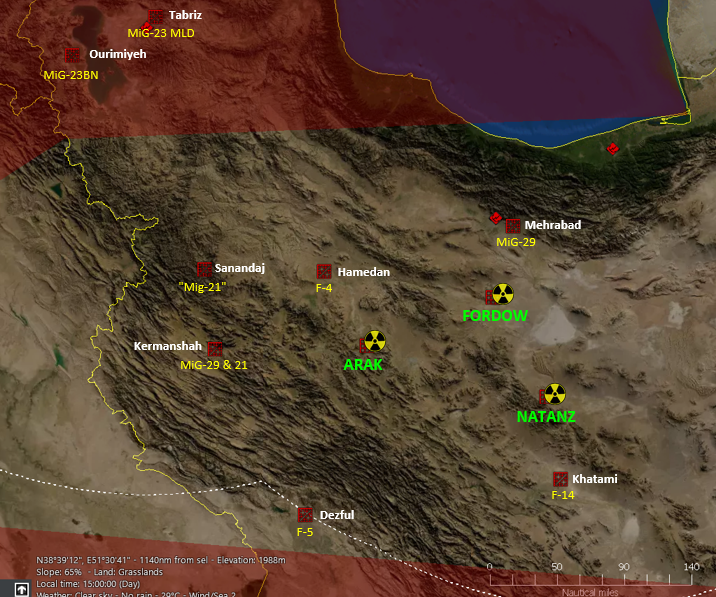
The complication is that nobody wants the hassle (real or political) of radioactive contamination, so we’re expected to hit everything around the nuclear material, while leaving the actual source of the problem intact. This will be a particular problem at Arak, where the sensitive reactor is only about 200m from the turbines we’re expected to destroy!
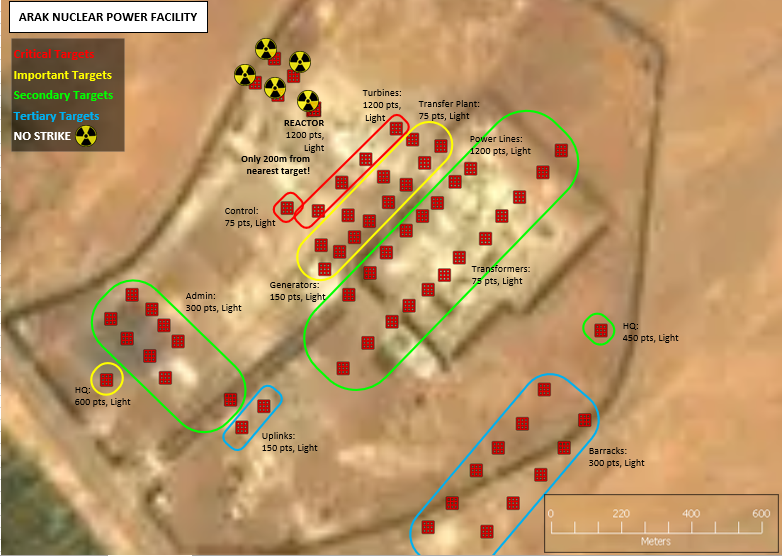
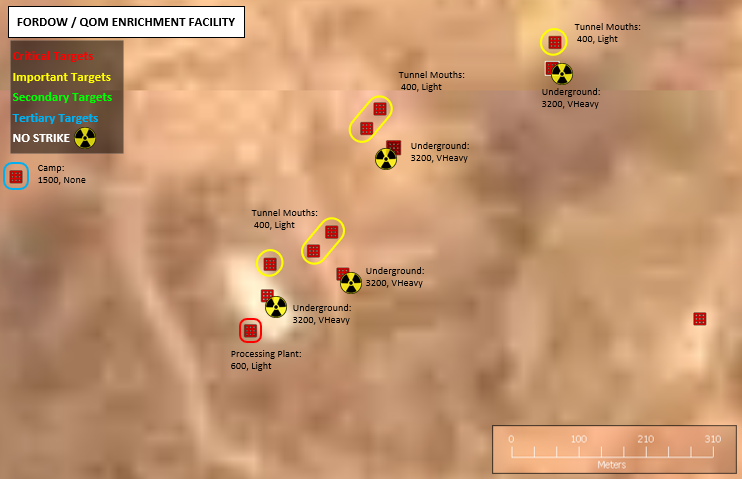
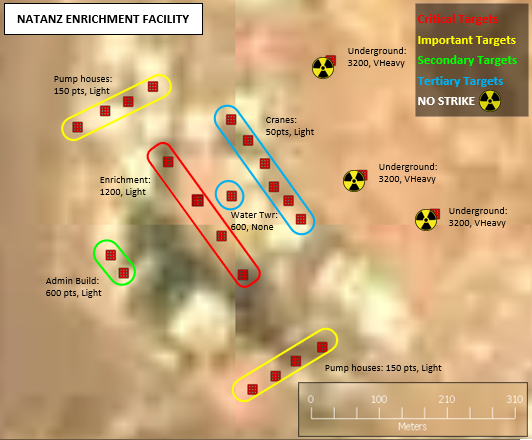
Iran (and the Soviet force based there) has taken a bit of a beating over the last few days, but they are still expected to have useful defences from their fighters and SAMs. Their airpower in the region includes a dwindling number of F-14s, MiG-29s and F-4s, and an assortment of MiG-21-alikes and F-5s too. There are better aircraft, both Iranian and Soviet, in the north, up around the Caspian, but hopefully we won’t have to deal with them. Presumably the nuclear centers have air-defences too, but at the moment we have no up-to-date information about those, which is a definite concern.
Our forces are mostly based out of Cairo. We’ve got numerous F-15s for fighter cover, while F-15Es and F-16s are available for the strike itself, and tankers, EF-111s, and an EC-130 are available for support. Higher command is already working on our recce problem, and an SR-71 and its specialized tanker are coming across the Med to take a ‘quick’ look at our targets, which is very welcome news. They also tell us that four strategic bombers are inbound across the Atlantic, a quartet of sleek B-1s loaded with heavy and light iron bombs. Our HQ receives this news with some reservations. There’s nothing precise about these guys, which is problematic when trying not to hit nearby infrastructure, and they come with a lot of ‘political prestige’ baggage. Lose one of these guys and they might forgive you. Lose two, and you’ve got some very unpleasant splainin to do. Asset or liability? The grumbling planning chief is not so sure.
PLAN
Only four of our F-15s are ready at the moment, and they are ordered to hurry east with a pair of tankers as soon as possible, with the EC-130 struggling along behind them. They are to enter Iran overtly and stir up as much trouble as possible, hopefully messing up CAP and triggering interceptions and SAM radars while the EC-130 listens in, and then burner back home again as soon as possible. They should just have time to do this and still reload in time to participate in the main strike. Unfortunately, they’ll be reloading with Sparrows, since AMRAAMs are in short supply, but they should still be able to pick on lesser aircraft, and its probably better to disrupt things in advance than wait for later.
Our F-15E strike aircraft are ordered to load LGBs, predominantly with 2000lb general purpose warheads, but some with smaller 500lb weapons too. It is tempting to rely on standoff weapons like the GBU-15s, to help stay out of SAM range, but the F-15s can only carry half as many of those, and there are so many aimpoints that we’ll need sheer quantity of warheads, even if they are short-ranged. Our F-16s are assigned to SAM suppression, with two-thirds of them loading HARMs, while the remainder load Mavericks. (Unfortunately, our F-16s don’t have night-vision pods, so cluster bombs in the dark would be a waste of time.)
The SR-71 should make its pass over Iran in about four hours, and if they find heavy SAM defences, we may need to postpone the strike a few hours to change loadouts. If not, the strike will start launching in about six hours, once the bombers arrive.
FIGHTER SWEEP
Our four heavily-armed F-15s launch immediately, overflying Israel and Jordan on military power, and tanking over the still-smoking ruins of Baghdad, before plunging into Iran, radars blaring. They quickly start getting indications of enemy fighter radars. There’s a pair of MiG-29s near Kermanshah, and multiple MiG-21-alikes, four to the north, and four to the south. Our pilots press the fight towards Kermanshah, engaging the MiG-29s and MiG-21s launching there, plus a brace of four Phantoms which come in from Hamedan. As our missiles dwindle, a lone F-14 comes in from Khatami, and lobs a couple of long-ranged shots in our direction. Fortunately, they’re not Phoenixes, and we manage to evade them at long range.
Missiles exhausted, our pilots turn west again and dash for the border on afterburner, pursued by a pair of MiG-29s and two MiG-21s. Fortunately, the enemy break off the chase, allowing our fighters to tank again, and then run for Cairo on afterburner. Our guys are claiming about twenty shot down (not bad for 32 missiles), half a dozen of them the good MiG-29s, but they never did catch the F-14.
As our fighters retire, the EC-130 keeps getting sniffs on radars of MiG-29s, F-4s, and MiG-21s, plus MiG-23s up near Tabriz. There’s also an AEW flying back and forth up near the Caspian, but it’s well outside our area for the moment. Our sweep obviously hasn’t punched a permanent hole in their defences, since they’re still patrolling, but hopefully we’ve chipped away at their redundancy. The secondary objective of finding SAM site radars was a complete failure, leaving us still in the dark about the Iranian defences.
BLACKBIRD
At 1630Z the SR-71 arrives and goes hurtling into Iran at Mach 3.2, and too many thousand feet to count, on a course that loops around past Arak, Fordow/Qom, and Natanz, and the associated airbases en-route. The flight is unopposed, other than a quartet of startled MiG-29s which are quickly left in the dust near Qom, and the cameras roll smoothly throughout the flight. The Blackbird exits Iranian airspace past Dezful, slows down to refuel over Baghdad, and then heads west across the Mediterranean towards home.
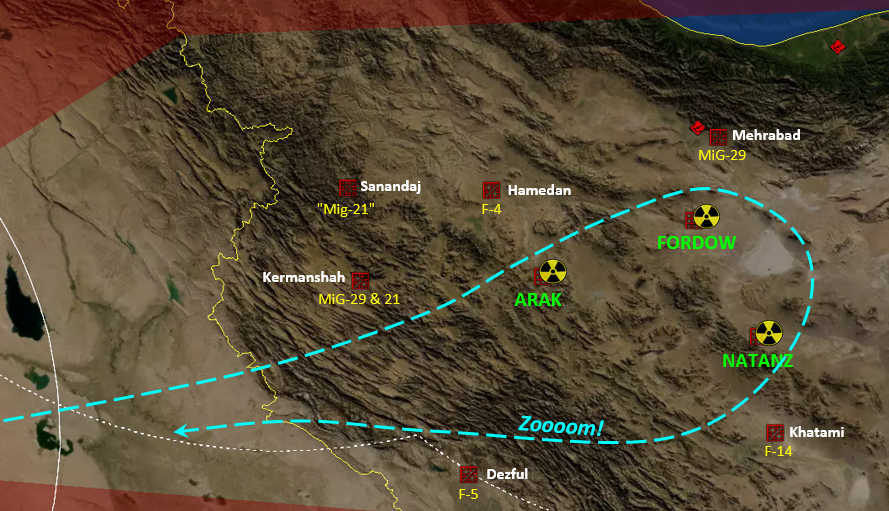
Analysts eagerly scrutinize the data, and are definitely surprised by what they find. Arak is surrounded by numerous small ground units, presumably AAA and MANPADS, but nothing else. Fordow/Qom has a modest amount of small units, and a single medium SAM of some sort. (Possibly a Rapier?) Natanz has tons of light units, primarily in two belts about 4 miles from the facility, and another ring immediately around the facility, but it too only has one medium SAM.
Where are all the heavy SAMs? The F-14 airbase at Khatami had a surveillance radar, two medium SAMs (not Rapiers – SA-11s?), and something big, probably an SA-10. There’s a single big SAM unit at Dezful airbase. There are also a couple of concentrations of ground units SW of Khatami, but they’re too far away to protect anything. Are our targets really undefended against high-altitude attack?
People are starting to wonder if devoting the entire F-16 force to SEAD was overkill, especially if the HARMs have nothing to shoot at. Maybe some contacts have been misidentified? Maybe mobile SAMs are being hidden in buildings or under camouflage? Well, if nothing else, the F-16s can always act as extra fighter cover.
In a few hours we’ll know if we made the right decision!
STRIKE – PHASE 1, FIGHTER PUSH
Our tankers start taking off at 1830Z, heading towards refuelling stations near Baghdad, followed by our fighters, EF-111s, F-16 SEAD planes and finally our F-15E strike aircraft. The B-1s are already on the scene, loitering in Iraqi airspace while they top up from tankers which they brought from Spain.
Our fighters head in while the rest of the strike is still arriving to refuel, fighting off MiG-21s and assorted MiG-29s, plus two lone F-14s (thankfully these have only shown up as singles), while fending off a quartet of F-4s which are making gestures from Hamedan. Unfortunately, we’re running out of missiles quickly, especially when facing the nimble MiG-29s; two of the F-15s are already headed home empty, and the strike hasn’t arrived yet. The bulk of our F-15s only have light loadouts, with two AMRAAMs and two Sidewinders, which is great for fuel economy, but rotten for combat endurance. I’m starting to think I should have changed some of them over to heavy Sparrow loads, and thus allowed the rest to carry heavy AMRAAM loads. Fortunately, all our strike aircraft carry a pair of AMRAAMs too, so they should be able to help defend themselves when they arrive.
Our strike comes off the tankers and starts moving in, as our fighters keep trying to hold the airspace they need to advance. The F-4s get knocked down, another F-14 arrives and dies, and we start picking up Flanker radars over the Caspian, and their AEW too. Our fighters advance, with two flights of F-15s and an EF-111 heading for each of the inland targets (Fordow and Natanz), while the remainder guard the north side of the strike route. Four more F-4s make a short-lived sortie from Hamedan, and two pairs of MiG-29s take off from Meherebad. We manage to get three of the MiG-29s, but the fourth escapes back home into SAM cover. One enterprising Eagle pilot, however, gets a glimpse of the Adnan AEW on radar, and it’s less than 80 miles away. A brief afterburner dash puts him in front of the converted cargo jet, and his last Sidewinder neatly punches through the cockpit window, sending their best surveillance asset plummeting to the ground.
Multiple F-15s are heading home without missiles now, as the strike keeps heading east, and naturally that’s when more fighters pop up behind us: F-7s at Sanandaj, and MiG-29s at Kermanshah. Our trailing F-15s move in to intercept them, which works, but there go the last of my good rearguard missiles. If there’s much more of this, my strike planes will have to start defending themselves.
STRIKE – PHASE 2, ARAK
The closest (and largest) target is the reactor complex at Arak, so it naturally attracts the majority of our resources. All four of the B-1s are headed here, as are the bulk of our F-15Es. The HARM-carrying F-16s are divided equally (four each) among the three targets, but all six of the Maverick carrying ones go to Arak.
The F-16s arrive ahead of the strike, but nothing’s radiating, so the first flight of Maverick-armed planes dives in to engage a cluster of four densely packed ‘3-strength’ units west of Arak. The thought is that they might be light SAMs, and engaging them might force any other hidden SAMs to light up. Four Mavericks go hurtling in, getting a couple of hits, and small radars do indeed light up throughout the region, but they turn out to be Skyguards, for 35mm AAA, not SAMs. Knowing that helps complete the picture. There are several more clusters around Arak which are presumably other Skyguard units, but there are also two isolated units, one east and one west of the complex, which never lit up a radar. Those are very likely RBS-70s, a particularly nasty laser-beam riding heavy MANPADs system, which we have met before in Iran. The rest of the F-16s turn their focus on those, and destroy them with more Mavericks, while staying safely above their ceiling.
At 2137Z the four sleek B-1s drop to 3650m, make a final course adjustment, swing their wings back and engage their afterburners. Ground-mapping radars turn on, OECM starts blaring, and supersonic shockwaves pummel the ground behind them. They streak over the Arak complex above the light AAA ceiling, laying strings of iron bombs across the densely packed electrical equipment south-east of the reactor, and in moments they are gone into the night.
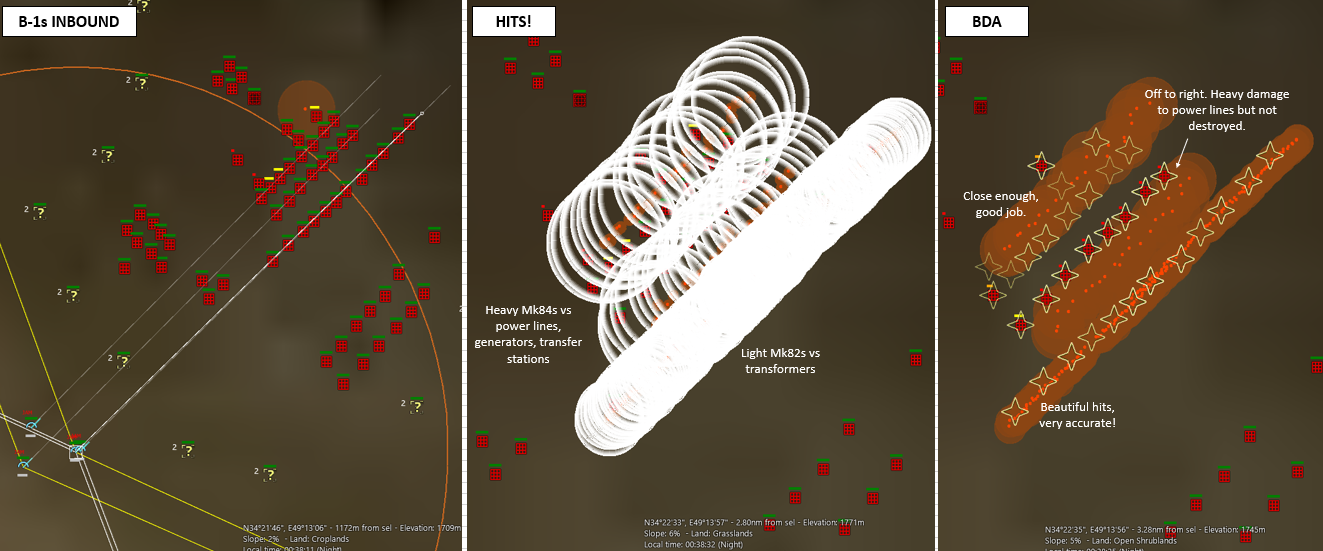
The lines of crashing explosions light up the night in a spectacular storm of destruction, and it’s almost as good as we’d hoped. The lines of Mk 82s were beautifully placed, accounting for all twelve of the transformers, and one stick of Mk 84s dropped between the generators and transfer plants accounts for eleven targets, leaving only one generator standing. (Although the F-15Es contest this, claiming collateral damage from their own bombing had already destroyed one of the transfer plants and damaged the others.) The last stick of Mk 84s, aimed at the power lines, misses to the right, causing heavy damage to the towers, but leaving them standing. Their open structure is apparently quite resistant to blast and frag damage. (Normally you would aim across a linear feature at a slight angle, to avoid misses like this, but in this situation I want absolutely no part of the bomb string pointing anywhere remotely near the reactor, so this is the result.)
The F-15Es complete the bombardment of the area, and a combination of heavy and light LGBs are dropped from the complete safety of high altitude, on trajectories which do not point towards the reactor. Systematic destruction follows, and the careful choice of aimpoints leaves the facilities in ruins, while the reactor is still intact.
STRIKE – PHASE 3, FORDOW & NATANZ
The other two target sites are considerably smaller than Arak, and in both cases their “hot” nuclear facilities are well buried, so collateral damage is less of a concern.
A single flight of F-15Es is sent to Fordow, arriving at 2145Z, and it manages to account for most of the aimpoints with heavy LGBs. Several bombs malfunction, unfortunately, so the reserve flight has to be called in from Arak, and they finish off the targets without difficulty. No enemy fighters interfere, and I suspect the loss of their AEW plane means they don’t have good contacts on us. There is a Rapier SAM at Fordow, but it is completely incapable of engaging the incoming weapons, so it is bombed and destroyed on the way out, as a matter of principle.
Natanz is assigned two flights of F-15Es, one with heavy LGBs and the other with light LGBs, arriving at 2150Z. Unlike Fordow, our strike on Natanz does attract enemy attention, and an intermittent string of F-14s take off from nearby Khatami. Fortunately, they’re only appearing one at a time, and we have four F-15s on station to repel them. The Iranian missiles do outrange ours, but while one of our planes is turning and outrunning the incoming weapon, the other three can close in and engage the enemy, so the F-14s are shot down without loss. Meanwhile our F-15Es destroy their assigned aimpoints, as well as the Rapier here too. (It would be rude not to.)
The HARM-carrying F-16s overwatching Natanz ask for permission to engage some of the radars down at Khatami, where an SA-10, two SA-11s, and a surveillance radar have been detected. It’s tempting, but probably wouldn’t cause any decisive damage, so the request is denied. Better to save the missiles for later.
HOMEWARD BOUND
The strike is complete by 2215Z, with all aimpoints reported destroyed, and our long string of aircraft turn and head west for the tankers and home. Some F-15Es, with plenty of gas left and all their AA missiles still unused, form a rearguard, escorting the strike to safety. Two last brave MiG-21 pilots take off from Kermanshah as the retiring strike passes by, but the response is swift, and they are shot down within a few miles of their base.
By 2300Z, all our planes have crossed the border back into Iraqi airspace. Some (primarily the F-16s) need to pause at the tankers, but many have enough fuel to head directly back to Cairo. The bombers top up, and prepare for the excruciatingly long trip back to the continental USA, and I bring the scenario to a close. HQ seems pleased with the result, and it’s time to focus on the next mission.
Thanks for another fine scenario.
IMPRESSIONS
This is a nice, focused scenario, with clearly defined objectives, and it all seemed to work well. It would make a very good stepping-stone for new players transitioning from initial small scenarios to something of medium complexity. The balance of power is definitely in the player’s favour. Although my dedicated F-15C fighters were running low on missiles and starting to retire, every strike plane was toting two AMRAAMs and two front-aspect Sidewinders, which meant I still had potent air-to-air capability throughout the scenario.
I was suspicious about the usefulness of the bombers, but they actually did a good job in the end, somewhat to my surprise. It takes a reasonably permissive environment to use them, but in this case the player can make that happen, so it turned out all right. I reran the bomb-run a few more times after the game, to see if my performance was an anomaly, and I think my bomb-run was more towards the good end of the probability curve than the bad end. Bringing the bombers down lower, into flack range, would increase accuracy, but that’s risky with such valuable /assets. (Of course, eight F-15Es could probably do as much or more than the four B-1s, using the same number or crew in complete safety, but hey, that’s why there’s not much dumb carpet bombing any more!)